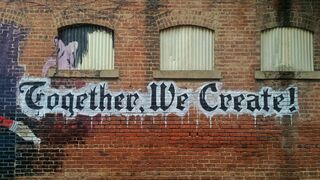Creativity
Bias in Support for Creativity: Another Glass Ceiling
A new study finds that organizations disadvantage women’s creativity at work.
Posted July 9, 2020 Reviewed by Matt Huston

A new paper in the journal Creativity and Innovation Management, authored by my colleagues and me, suggests that men receive greater support for creativity in the workplace than women do, and this greater support predicts more creativity and innovation at work.
Research on the role of gender in creativity shows a too-familiar picture. Men and women do not differ in their creative abilities, but there is a difference in how the creativity of men and women is viewed at work. When researchers have examined differences in creative abilities—abilities to come up with many and original ideas, identify connections among remotely associated concepts, or solve complex problems—they have not found an advantage for men or women.
These studies have administered tests of creative thinking to samples of both children and adults and examined creative thinking that does not require prior knowledge of a particular discipline (such as science, music, or marketing). For example, a test might ask people to think of alternate uses for everyday objects like a brick or a tin can. Across studies, on average, men and women tend to perform similarly. Another set of studies examined whether the creativity of men and women differs when they are asked to create something in the laboratory, such as a collage or poetry. Again, on average, men and women performed similarly.
However, creativity is not dependent only on ability. There are people who have the ability—the potential to be creative in what they do—but who do not achieve professional creativity. The social environment of work plays a significant role and can be a key difference between having the potential and realizing it. When gender enters social evaluations and social supports for creativity, we see evidence of bias.
In one experiment, researchers told people either that creativity involves the ability to think outside the box, seeing the world differently, and not conforming to traditions or that creativity involves the ability to connect the dots, see connections among ideas, and create something that brings ideas together in a unique way. People were then asked to rate how descriptive of creativity are different personality traits. The results showed that stereotypically masculine traits (e.g., being daring, self-reliant) were rated as most central for creativity and this relationship was especially pronounced when creativity was described as “thinking outside the box."
In another study, people first read a description of a creator. Everyone received the same descriptions, except that for one group of people the creator was identified as male and for another group as female. Then, both groups were asked to evaluate the same products (e.g., images of houses) ascribed to the creator. People tended to judge products they believed were made by a man as more creative than those they believed were made by a woman.
In addition to a bias disadvantaging women in evaluations of creativity, we were wondering to what extent men and women receive unequal support for creativity at work. Extensive research shows that people’s perception of how much their organization encourages, recognizes, and rewards creativity predicts what they do at work. Gender-based bias in support for creativity could thus result in real-world differences in what people achieve in their jobs.
To examine this, our study surveyed close to 15,000 working adults—a sample demographically representative of the U.S. working population across industries. In addition to gender, we asked about support for creativity (e.g., to what extent they are being encouraged to develop and suggest original ideas and solutions), about actual creativity and innovation at work (how often people give ideas for new projects, how often they contribute original ways to achieve goals), and about the nature of their jobs (in what industry they work, whether their specific job roles require creativity).
In line with our hypotheses, results showed that men describe having greater creativity support than women. In turn, this differential in support for creativity predicted gender differences in creative and innovative behavior at work. Those who receive greater support innovate more. Gender differences in support for creativity are most pronounced in industries with the fewest women.
In female-dominated industries, women do not receive greater support for creativity. Rather, the difference between genders is smaller in these industries because men receive less support in industries with fewer women. Why might this be the case? One option is that industries with more women may fundamentally not require as much creativity as those with more men. But we eliminated this explanation because the proportion of women in an industry was not related to the level of creativity required in one’s job.
Another explanation could be that stereotypes of creativity as masculine are not active in industries dominated by women. If there was no stereotyping of creativity as masculine, men would receive less support for creativity, but women would not be affected. We ruled out this explanation, too, because both men and women describe less support for creativity in industries with a higher proportion of women.
The third explanation is the most compelling. The way organizations support creativity is through management practices and actions of supervisors and leaders at all levels. In female-dominated industries, supervisors and managers might not consider creativity as relevant for their employees as a whole, regardless of whether they are men or women. If they think of creativity as typically masculine, they may discount it as irrelevant in a typically female industry and both men and women may receive relatively little support for creativity.
Why does this matter? The World Economic Forum lists creativity skills as crucial for the changing economy. Women make up 47% of the U.S. workforce. Yet they are not likely to receive equal support for creativity, support that is crucial to enable creativity and innovation at work. This bias could hurt organizations by preventing them from fully utilizing the human potential of all their employees. And it could hurt women who are not equally respected today or encouraged to develop their creative potential, which will likely be increasingly important for attaining job security and advancing in their jobs in the future. This research highlights a need for greater equality in support for creativity and for leveling the field for creativity at work.
References
Taylor, C., Ivcevic, Z., & Brackett, M. A. 2020). Gender and creativity at work. Creativity and Innovation Management. Advanced online publication. doi: 10.1111/caim.12397
Proudfoot, D., Kay, A. C., & Koval, C. Z. (2015). A gender bias in the attribution of creativity: Archival and experimental evidence for the perceived association between masculinity and creative thinking. Psychological Science, 26, 1751–1761. https://doi.org/10.1177/
0956797615598739
Baer, J., & Kaufman, J.C. (2008). Gender differences in creativity. Journal of Creative Behavior, 42,75-105.




